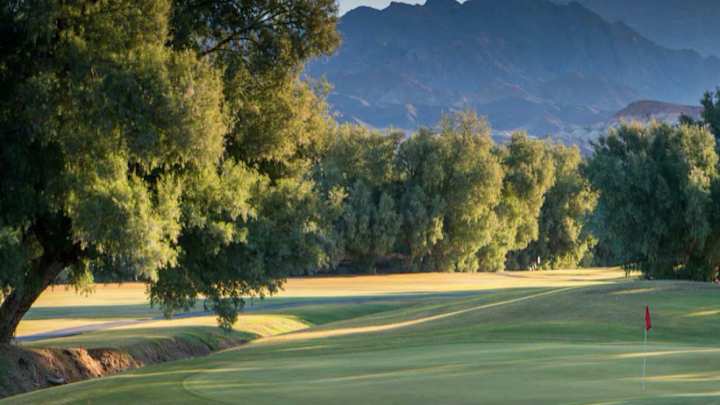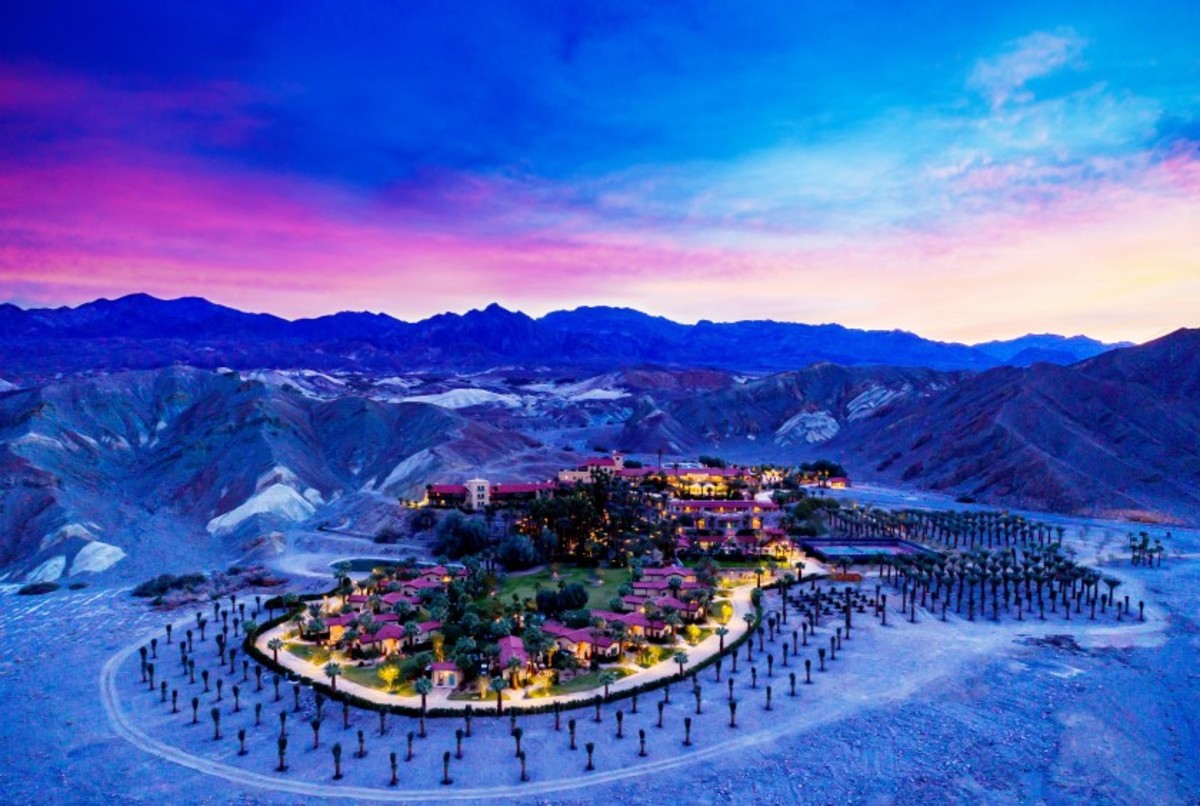Golf in the desert — Death Valley's Furnace Creek

DEATH VALLEY, Calif. — Most of us who cherish golf as a sport, hobby or passion have a bucket list. The normal suspects include rounds at Pine Valley, Pebble Beach, St. Andrews and Pinehurst No. 2, or a week with the guys in Myrtle Beach.
Logging 18 holes on a course located at the hottest place on Earth likely wouldn’t even be in our rear view mirror of golfing aspirations. It’s uncomfortable shooting triple digits as it is, but teeing it up in 100-plus degree temperatures in Death Valley — now that’ a hellacious golf excursion.
Partners in your foursome at Furnace Creek Golf Course at Death Valley could include scorpions, road runners or a coyote or two. Believe it or not, there is water located on nine holes, but refrain from jumping in to cool off as the oppressive heat in this remote location of the Mojave Desert can beat down you and your game.
How hot does it get on this golf course? Well, in July 1913 the United States Weather Bureau recorded a high temperature of 134 degrees at Furnace Creek, a temperature reading that still stands as the highest ambient air temperature ever recorded at the surface of the Earth.
You know you’re in for an atypical golfing encounter when a pro shop sells T-shirts with a skeleton swinging a club.
It’s hard to believe that — at 214 feet below sea level — this is the world’s lowest golf course. It was born 93 years ago by a date palm caretaker by the name of Murray Miller, who created a three-hole course. It was expanded to nine holes in 1931 and became the first grass golf course in the California desert region. In 1968, William F. Bell designed the second nine holes and three decades later Perry Dye redesigned the course and installed a full irrigation system.
Furnace Creek, also ranked among the nation’s 50 most difficult layouts with a rating of 74.7, is complemented by the luxurious Inn at The Oasis at Death Valley and the more casual Ranch at The Oasis at Death Valley – a rare oasis in the middle of the 3.4 million acres of Death Valley National Park. Known to the Hollywood elite such as Clark Gable and Ronald Regan since the late 1920s, this unique resort just completed a major renaissance.

Dye, the son of the late, great Hall of Fame architect Pete Dye, has a design resume as long as the sun is hot here. He remembers soaking in all the surrounding sights and desert colors during his first site visit to begin "refreshing” the course surrounded by barren land.
“I haven’t seen all of the world’s parks or all of the world’s mountains, but I have traveled a lot around the world and Furnace Creek is just unbelievably different, and special in its own way,” Dye said. “You can get the satellite pictures out and look at them and see how far it is to the next green grass. I thought if I was an animal I would be hanging around this golf course every day, too.
“How can you say that Death Valley is not more unique than any other place in the world? It really is a living, breathing museum. I love playing golf next to the ocean as much as the next guy, but Death Valley is more than fascinating. It is a shining star in a funny world.”
Located two hours from Las Vegas and 267 miles from Los Angeles, Dye’s marching orders more than two decades ago was to add a bit of character to the layout and produce a more family-friendly experience.
“It was a very expansive type of golf, and when you get into that you need to have multiple tees and try to make it as fair as you can for everybody,” he said. “We did have some fun with it. I can remember digging out a couple of lakes and found golf balls from the 1920s and ‘30s, which was more than surprising.
“For the resort to even keep golf going here shows a real love of the game because at 214 feet below sea level it’s hard to take care of a golf course. People expect golf, but what they really expect is to watch those coyotes run down the fairway and go nuts. During the construction it was more of a technical challenge than it ever was a design challenge. We had to design it to where the water worked, the grassed worked -- all those other little things that were available to us -- so when we left we still had a golf course that was sustainable.”
#BadwaterBasin is known for its scenic salt flats. But in 2005, so much rain fell that a lake formed here & visitors kayaked on the floor of #DeathValley!
— Oasis Death Valley (@TheOasisDV) April 15, 2020
Read: https://t.co/BPVhP3QOGM#OneWeekOfStories | #RoamFromHome | #OasisAtDeathValley | #XanterraTravel | #Day3 pic.twitter.com/5Xr44YJLQE
Most can agree that it would take a lifetime to see all of Death Valley, a national park that ranges in elevation from Badwater Basin, the lowest point in North America at 282 feet below sea level, to the snowcapped heights of 11,049-foot Telescope Peak in the Panamint Range. There are expansive salt flats and intimate, serpentine canyons, plus geological features from volcanic craters to sand dunes. And given the right conditions, Death Valley can put on spectacular displays of spring wildflowers.
But Dye still chuckles about one particular request from ownership.
"They asked me one day 'what about adding some flowers to the golf course?'" Dye said. “I said 'not many of them are going to last 10 hours out here – at night.' Some people try to think of Death Valley as Palm Springs. Well, Death Valley is not Palm Springs. And this is not Vegas. There are no water fountains, it’s so hot sometimes the water just disappears."
But believe it or not, and despite such an outward barren topography, there is water here. Almost 800 documented springs dot Death Valley National Park. They occur throughout the park, from below sea level on the valley floor to almost 11,000 feet elevation. Some springs dry periodically, while others are reliable water sources that have flowed for ages. Regional aquifer springs, including three Furnace Creek Springs provide a water source for the golf course, along with the resort itself, including its refurbished pool.
Exploring the various aspects of Death Valley, its solitude and virtual silence, its splendor and scenery, are a once-in-a-lifetime draw.
Oasis at Death Valley resort general manager Trey Matheu was working at Yellowstone in July 2018 when he and his wife took sort of "a flyer" and made the professional leap to Death Valley.
"When I came to interview it was 118 degrees and I had never been that hot before, but the thing that struck me was how livable it was to be honest with you," Matheu said. “From my perspective what really sold me on the property was the renovation they had completed at the inn. I had heard about it a lot, but when I got to see it, touch it, feel it, I was blown away with the entire property. It wasn’t until a little bit later that I fell in love with Death Valley when my wife and I could get out and start using the park itself.”
The renovated property is privately owned by Xanterra Travel Collection. It features 66 mission-style rooms and a Tranquility Spa. More than 800 additional palm trees were planted at the resort property to accentuate a garden paradise. Room upgrades provide a true boutique experience, while the patio overlooking the spring-fed pool offers stunning panoramic views of the desert and mountain ranges. In addition, 22 stylish one-bedroom casitas have been added for small groups.
“Before we started our $150 million in improvements we were considered a typical hotel that happened to be in a national park,” Matheu said. “But with the vision, with the owner’s direction and quite frankly the investment we’ve made in the infrastructure and what we’re trying to add for amenities and activities, what we are becoming is a destination resort that just happens to be in the largest national park outside of Alaska as one of its amenities."

Furnace Creek director of golf Jordan Wetsch was an assistant pro at a Chicago club and in the middle of the winter drove to Death Valley for a job interview in December. He had the top down on his Chevrolet Camaro as he weaved his way along breathtaking Highway 190 toward the resort.
“Wow, it felt like Mars in a way,” Wetsch said. “I was just blown away.”
Equally impressive is the view from the famous drive-thru 19th hole at the golf course, which has to be one of the most laid-back, post-round watering hangouts in the United States.
“You can sit there all day,” Dye said of the view. “There are a lot of great places to be, you can sit and watch the ocean all day, but to roll into a place and see this it’s just fascinating. Don’t spoil it and write too many good articles about it because it is a keeper. It really is.”
Part of the allure of the area, besides its constant changing palettes of varying colors within the 3.4 million acre park, is its tales and oddities. Back in the day, this area was known as the borax mining capital of the U.S., 80,000 gallons of water bubble to the surface of the oasis every day, George Lucas filmed some of the original Star Wars movie close by and Hall of Fame golfer Phil Mickelson got his first set of clubs as a 10-year-old at Furnace Creek Golf Course.
“Mickelson had a tournament in San Diego and his dad said if he won the tournament he would buy Phil a new set of clubs,” Matheu said. “They were coming here for a vacation and they showed up at the pro shop. They had a lefty set of women’s clubs that were his size so they bought them.”
Upon arrival at the resort parking lot, take the dark stoned tunnel to an elevator to check in to help celebrate the mining history, and when checking in at the golf course don’t forget your cool, wet towel -- and your camera.
“We like to say ‘Welcome to Death Valley, where every night is a Friday night and every morning is a Monday morning,”’ Matheu said.
Sign up to receive the Morning Read newsletter, along with Where To Golf Next and The Equipment Insider.
